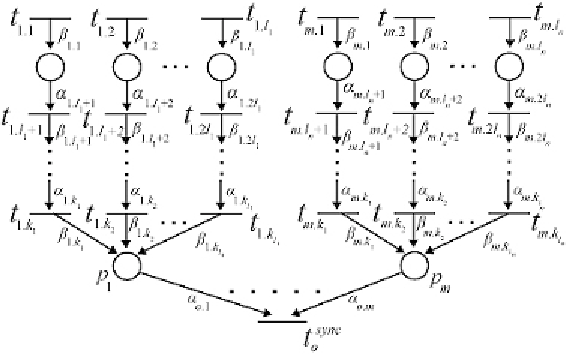Biology Reference
In-Depth Information
sync
o
Fig. 12. Schematization of the structure of synchronous transition
t
.
A synchronous transition
t
syn
i
connected from two or more input places becomes firable if all the
input places have a sufficient amount of tokens satisfying the firing condition. Due to the feature of
retention-free Petri net, it is necessary to synchronize the timing that each input place of
t
syn
i
becomes
firable. It leads us to consider the condition to determine the delay time for the synchronous transitions
in order to avoid token-retention at multiple input places merged to the same synchronous transition. The
condition is, if there is a synchronous transition
t
sync
as shown Fig. 12, the maximum firing frequency
o
satisfies the following equation:
f
1
.
1
β
1
.
1
1
...β
1
.k
1
β
1
.
2
...β
1
.k
2
β
1
.I
1
...β
1
.k
l
1
α
1
.
2
I
1
...α
1
.k
l
1
α
o.
1
·
α
1
.I
1
+1
...α
1
.k
1
+
f
1
.
2
·
α
1
.I
1
+2
...α
1
.k
2
+
...
+
f
1
.I
·
·
.
(6)
f
m.
1
β
m.
1
...β
m.k
1
β
m.
2
...β
m.k
2
β
m.I
n
...β
m
.k
l
n
α
m.
2
I
n
...α
m.k
l
n
1
α
o.m
=
·
α
m.I
n
+1
...α
m.k
1
+
f
m.
2
·
α
m.I
n
+2
...α
m
.k
2
+
...
+
f
m.I
n
·
·
Equation (6) is an expression formulated by the firing frequency of each input place of the synchronous
transition obtained by using expressions (2), (3) and (5).
Algorithm of automatically determining delay time of each transition
We develop an algorithm to automatically determine delay time of transitions according to expressions
(2), (3) and (5). First we give the explanation of the notions used in our algorithm.
LT
is a list,
t
sync
t
sync
t
sin
2
...
, containing synchronous and sink transitions in such order
that if
i<j
then there is no directed path from
t
sync
t
sink
·
·
...
·
·
1
2
1
j
to
t
syn
i
.
T
sync
and
T
sour
are sets of synchronous
and source transitions, respectively.
EQ1
(
t
sync
) is a function that outputs conditional expression of a
synchronous transition
t
sync
based on Eq. (6).
EQ2
(
p
) is to produce expression (5) for a conflict place
p
and
EQ3
(
p
) is to produce expressions (2) and (3) for a conflict-free place
p
.
push
(
stack
,
p
) is a stack
operation pushing a place
p
into the stack
stack
.
pop
(
stack
) is a stack operation pulling out from
stack
.
T
e
is a set of transitions whose delay times have been derived from
EQ2
(
p
) and
EQ3
(
p
).













